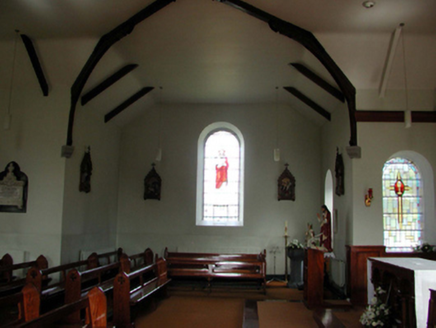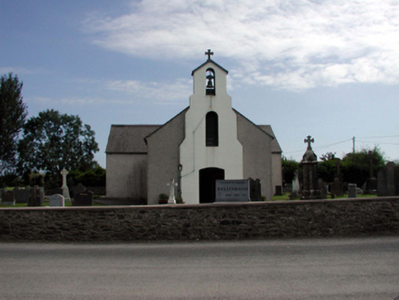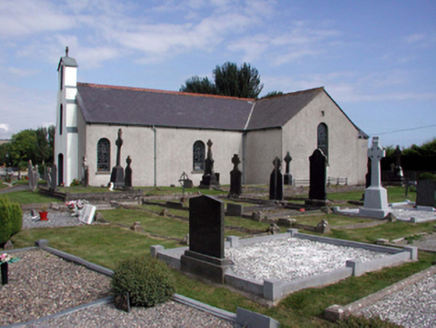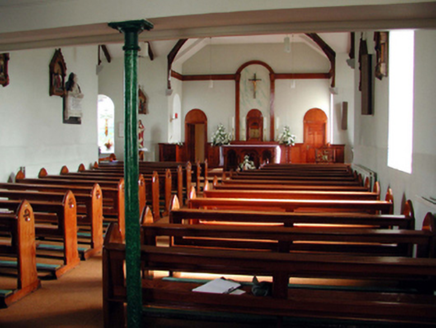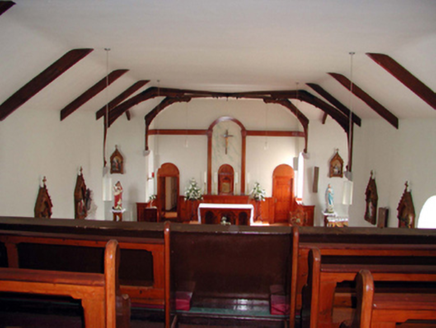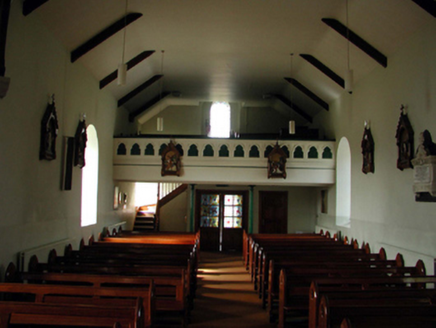Survey Data
Reg No
22903111
Rating
Regional
Categories of Special Interest
Architectural, Artistic, Historical, Social, Technical
Original Use
Church/chapel
In Use As
Church/chapel
Date
1800 - 1805
Coordinates
229388, 94754
Date Recorded
05/01/2004
Date Updated
--/--/--
Description
Detached four-bay double-height Catholic church, dated 1804, on a cruciform plan comprising two-bay double-height nave opening into single-bay (single-bay deep) double-height transepts centred on single-bay double-height chancel to crossing (east). Renovated, ----, with sanctuary reordered. Pitched slate roof on a cruciform plan with perforated crested terracotta ridge tiles, and cast-iron rainwater goods on rendered cut-limestone eaves retaining cast-iron downpipes. Roughcast battered walls on rendered base; rendered, ruled and lined buttressed breakfront to entrance (west) front with rendered gabled bellcote to apex. Round-headed window openings with concrete sills, and concealed dressings framing fixed-pane fittings having stained glass margins centred on leaded stained glass panels. Camber- or segmental-headed door opening to entrance (west) front with concealed dressings framing diagonal timber boarded double doors. Round-headed opening (gable). Interior including vestibule (west); square-headed door opening into nave with glazed timber panelled double doors; full-height interior with choir gallery (west) on cast-iron pillars, carpeted central aisle between cruciform-detailed timber pews, paired Gothic-style timber stations between stained glass windows (----), wall monuments (1856; 1872), stepped dais to sanctuary to crossing (east) reordered, ----, with timber altar, and part exposed timber roof construction on ogee corbels. Set in landscaped grounds on a corner site with rendered piers to perimeter having gabled capping supporting wrought iron double gates.
Appraisal
A church representing an integral component of the ecclesiastical heritage of County Waterford with the architectural value of the composition, one showing the hallmarks of a period of construction coinciding with the gradual dismantling of the Penal Laws in anticipation of the Roman Catholic Relief Act, 1829, suggested by such attributes as the cruciform plan form, aligned along a slightly skewed liturgically-correct axis; the "arcaded" profile of the openings with those openings originally showing conventional Georgian glazing patterns; and the simple bellcote embellishing the roofline as a picturesque eye-catcher in the landscape. Having been well maintained, the form and massing survive intact together with quantities of the original fabric, both to the exterior and to the interior reordered (----) in accordance with the liturgical reforms sanctioned by the Second Ecumenical Council of the Vatican (1962-5) where a part exposed timber roof construction pinpoints the engineering or technical dexterity of a church making a pleasing visual statement in a suburbanised village street scene.
